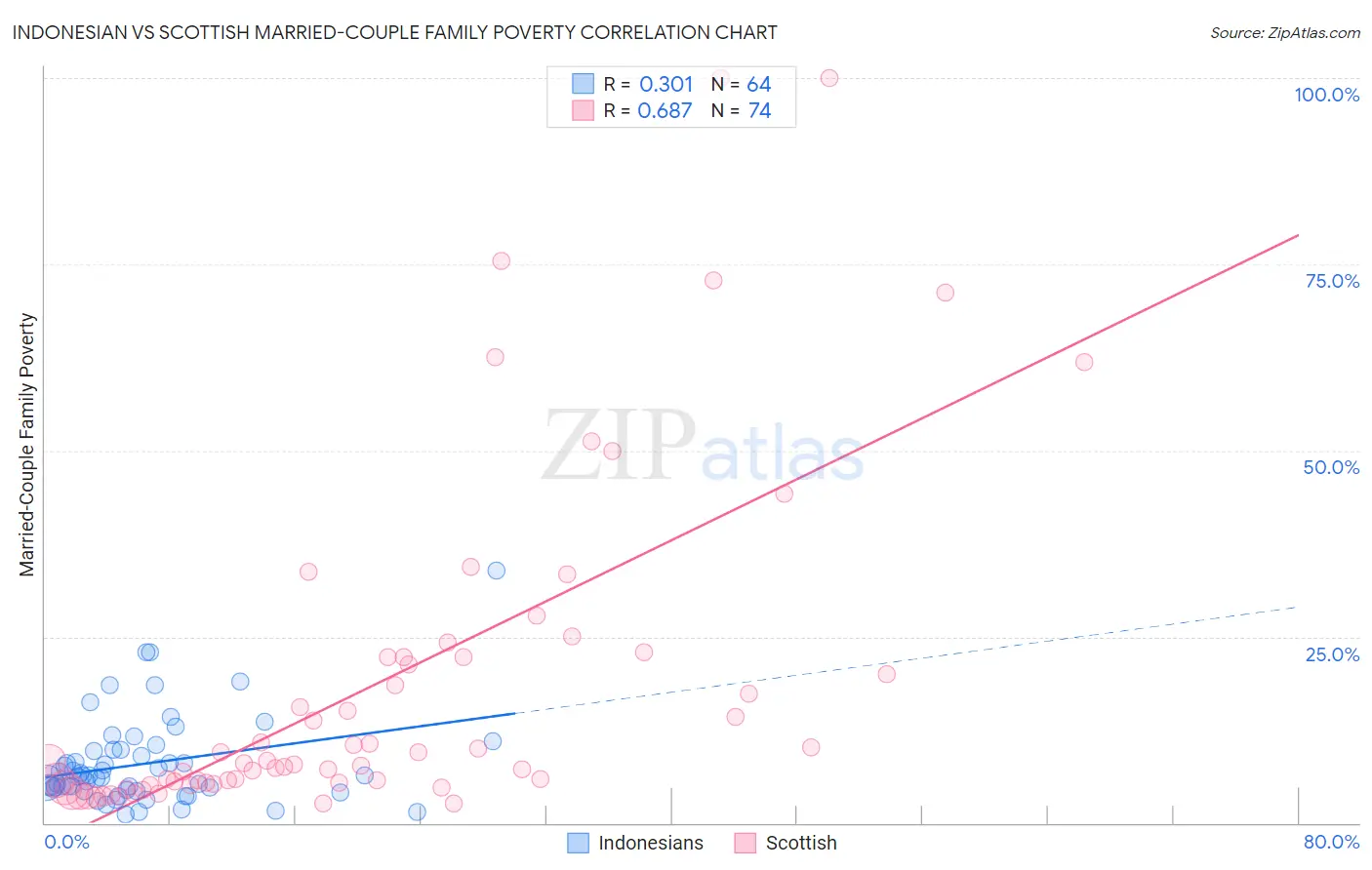Indonesian vs Scottish Married-Couple Family Poverty
COMPARE
Indonesian
Scottish
Married-Couple Family Poverty
Married-Couple Family Poverty Comparison
Indonesians
Scottish
6.3%
MARRIED-COUPLE FAMILY POVERTY
0.1/ 100
METRIC RATING
277th/ 347
METRIC RANK
4.3%
MARRIED-COUPLE FAMILY POVERTY
99.8/ 100
METRIC RATING
42nd/ 347
METRIC RANK
Indonesian vs Scottish Married-Couple Family Poverty Correlation Chart
The statistical analysis conducted on geographies consisting of 162,334,988 people shows a mild positive correlation between the proportion of Indonesians and poverty level among married-couple families in the United States with a correlation coefficient (R) of 0.301 and weighted average of 6.3%. Similarly, the statistical analysis conducted on geographies consisting of 552,662,179 people shows a significant positive correlation between the proportion of Scottish and poverty level among married-couple families in the United States with a correlation coefficient (R) of 0.687 and weighted average of 4.3%, a difference of 48.4%.

Married-Couple Family Poverty Correlation Summary
| Measurement | Indonesian | Scottish |
| Minimum | 1.2% | 2.6% |
| Maximum | 33.8% | 100.0% |
| Range | 32.6% | 97.4% |
| Mean | 7.9% | 18.6% |
| Median | 6.3% | 8.2% |
| Interquartile 25% (IQ1) | 4.5% | 5.4% |
| Interquartile 75% (IQ3) | 9.8% | 22.2% |
| Interquartile Range (IQR) | 5.2% | 16.8% |
| Standard Deviation (Sample) | 6.0% | 22.5% |
| Standard Deviation (Population) | 5.9% | 22.4% |
Similar Demographics by Married-Couple Family Poverty
Demographics Similar to Indonesians by Married-Couple Family Poverty
In terms of married-couple family poverty, the demographic groups most similar to Indonesians are Yaqui (6.3%, a difference of 0.14%), Immigrants from Trinidad and Tobago (6.4%, a difference of 0.48%), Choctaw (6.3%, a difference of 0.59%), Houma (6.4%, a difference of 0.73%), and Barbadian (6.3%, a difference of 0.75%).
| Demographics | Rating | Rank | Married-Couple Family Poverty |
| Immigrants | Jamaica | 0.1 /100 | #270 | Tragic 6.2% |
| Immigrants | Bahamas | 0.1 /100 | #271 | Tragic 6.2% |
| Trinidadians and Tobagonians | 0.1 /100 | #272 | Tragic 6.2% |
| Colville | 0.1 /100 | #273 | Tragic 6.3% |
| Barbadians | 0.1 /100 | #274 | Tragic 6.3% |
| Choctaw | 0.1 /100 | #275 | Tragic 6.3% |
| Yaqui | 0.1 /100 | #276 | Tragic 6.3% |
| Indonesians | 0.1 /100 | #277 | Tragic 6.3% |
| Immigrants | Trinidad and Tobago | 0.1 /100 | #278 | Tragic 6.4% |
| Houma | 0.0 /100 | #279 | Tragic 6.4% |
| West Indians | 0.0 /100 | #280 | Tragic 6.4% |
| Mexican American Indians | 0.0 /100 | #281 | Tragic 6.4% |
| Seminole | 0.0 /100 | #282 | Tragic 6.4% |
| Ute | 0.0 /100 | #283 | Tragic 6.4% |
| Dutch West Indians | 0.0 /100 | #284 | Tragic 6.4% |
Demographics Similar to Scottish by Married-Couple Family Poverty
In terms of married-couple family poverty, the demographic groups most similar to Scottish are Northern European (4.3%, a difference of 0.16%), French Canadian (4.2%, a difference of 0.41%), Swiss (4.3%, a difference of 0.44%), Immigrants from Northern Europe (4.2%, a difference of 0.70%), and Immigrants from Japan (4.3%, a difference of 0.81%).
| Demographics | Rating | Rank | Married-Couple Family Poverty |
| Europeans | 99.9 /100 | #35 | Exceptional 4.2% |
| English | 99.9 /100 | #36 | Exceptional 4.2% |
| Iranians | 99.9 /100 | #37 | Exceptional 4.2% |
| Belgians | 99.9 /100 | #38 | Exceptional 4.2% |
| Immigrants | Northern Europe | 99.8 /100 | #39 | Exceptional 4.2% |
| French Canadians | 99.8 /100 | #40 | Exceptional 4.2% |
| Northern Europeans | 99.8 /100 | #41 | Exceptional 4.3% |
| Scottish | 99.8 /100 | #42 | Exceptional 4.3% |
| Swiss | 99.8 /100 | #43 | Exceptional 4.3% |
| Immigrants | Japan | 99.8 /100 | #44 | Exceptional 4.3% |
| Serbians | 99.8 /100 | #45 | Exceptional 4.3% |
| British | 99.8 /100 | #46 | Exceptional 4.3% |
| Immigrants | South Central Asia | 99.8 /100 | #47 | Exceptional 4.3% |
| Australians | 99.7 /100 | #48 | Exceptional 4.3% |
| Turks | 99.7 /100 | #49 | Exceptional 4.3% |